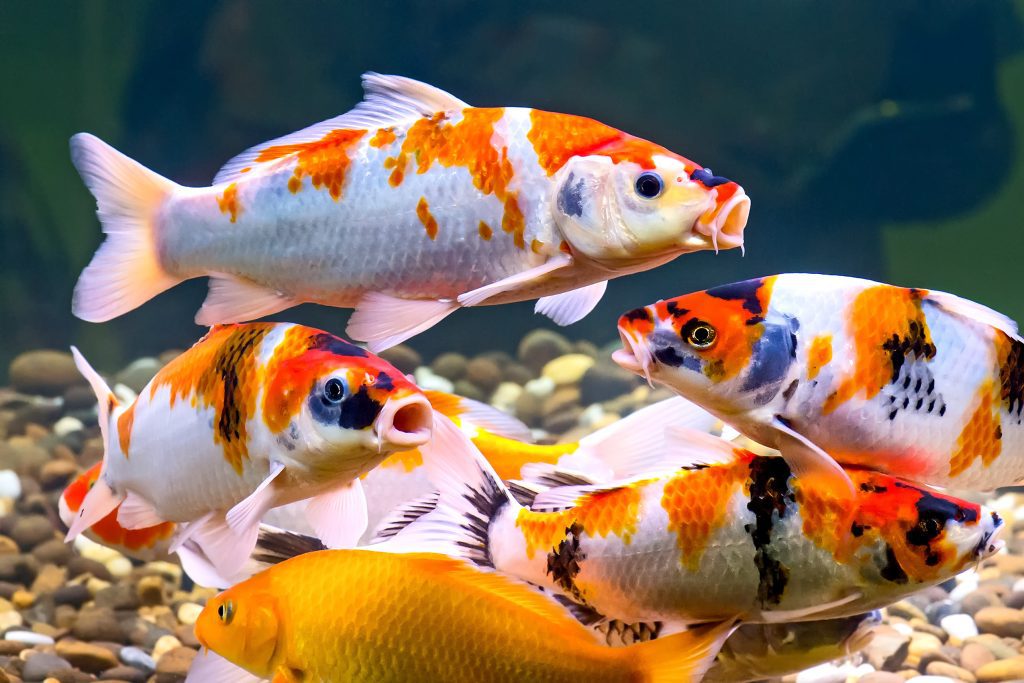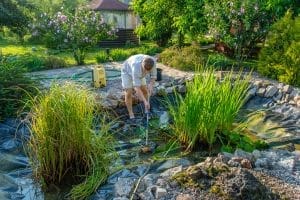
Koi Pond Treatments for Optimal Pond Water Quality: Essential Steps for Crystal-Clear Results
Koi ponds are delightful additions to any garden, offering a tranquil oasis and a chance to observe beautiful fish. But keeping these aquatic environments healthy requires careful attention to water quality. Proper treatments and regular maintenance are essential for ensuring optimal conditions for koi fish to thrive.

Maintaining good water quality in a koi pond involves more than just adding chemicals. It’s about creating a balanced ecosystem that supports the fish, plants, and beneficial bacteria. This balance helps prevent common problems like algae overgrowth and keeps the water clear and clean.
Choosing the right treatments for your koi pond depends on various factors, including pond size, fish population, and local climate. Regular testing of water parameters such as pH, ammonia levels, and dissolved oxygen can guide pond owners in selecting appropriate treatments and adjustments.
Key Takeaways
- Regular water testing guides treatment choices for koi ponds
- A balanced ecosystem supports fish health and water clarity
- Proper maintenance prevents common problems in koi ponds
Understanding Koi Pond Ecosystems
Koi ponds are complex ecosystems that require careful management to maintain water quality and fish health. Proper filtration and plant life play crucial roles in creating a balanced environment.
Biological and Mechanical Filtration Systems
Koi pond filtration systems are essential for maintaining clean water. Mechanical filters remove debris and large particles from the water. These filters use screens or foam to trap solid waste.
Biological filters, on the other hand, use beneficial bacteria to break down harmful substances. These bacteria convert ammonia from fish waste into less toxic compounds.
A well-designed filtration system combines both types. This dual approach ensures clear water and a healthy habitat for koi. Regular cleaning of filters is vital to keep them working properly.
Role of Aquatic Plants in Water Quality
Aquatic plants are more than just decoration in a koi pond. They help improve water quality in several ways. Plants absorb excess nutrients that can lead to algae growth.
Some plants, like water lilies, provide shade. This shade helps keep water temperatures stable and reduces algae. Floating plants, such as water lettuce, remove nitrates from the water.
Plants also offer hiding spots for koi, reducing stress. This can lead to healthier fish overall. A mix of different plant types creates a balanced ecosystem. It’s important to choose plants that are compatible with koi and suited to your climate.
The Importance of Water Parameters

Water parameters play a crucial role in maintaining a healthy koi pond ecosystem. Proper levels ensure fish health and overall pond balance.
Maintaining Proper PH Levels
PH levels are vital for koi health and well-being. The ideal range for koi ponds is between 7.0 and 8.6. Levels outside this range can stress fish and affect their immune systems.
Regular testing is essential. Use a reliable test kit to check PH at least once a week. If levels are off, adjust them slowly. Sudden changes can harm koi.
To raise PH, add crushed coral or limestone. To lower it, use peat moss or driftwood. Always make gradual adjustments to avoid shocking the fish.
Hardness, Alkalinity, and Other Chemical Considerations
Water hardness and alkalinity are key factors in pond health. Hardness measures dissolved minerals, while alkalinity indicates the water’s ability to buffer PH changes.
Aim for a general hardness (GH) of 100-200 ppm and a carbonate hardness (KH) of 80-120 ppm. These levels support koi health and plant growth.
Other important parameters include:
- Ammonia: Should be 0 ppm
- Nitrite: Should be 0 ppm
- Nitrate: Keep below 40 ppm
Test these levels weekly. Use biological filtration and regular water changes to maintain good water quality. Add beneficial bacteria to help break down waste.
Koi Health Indicators in Water Quality

Water quality plays a crucial role in koi health. Monitoring key parameters helps prevent issues and maintain thriving fish.
Identifying and Managing Ammonia, Nitrite, and Nitrate Levels
Ammonia is highly toxic to koi. It comes from fish waste and uneaten food. Test for ammonia weekly, aiming for 0 ppm. If levels rise, do partial water changes and reduce feeding.
Nitrite is also dangerous. It forms as bacteria break down ammonia. Keep nitrite below 0.25 ppm through regular testing and water changes if needed.
Nitrate is less harmful but can stress koi in high amounts. Aim for under 40 ppm. Water changes and plants help control nitrates.
Use liquid test kits for accurate readings. Record results to spot trends over time.
Understanding the Nitrogen Cycle
The nitrogen cycle is key to a healthy koi pond. Beneficial bacteria convert toxic ammonia to safer nitrate.
Stage 1: Ammonia-eating bacteria turn ammonia into nitrite.
Stage 2: Different bacteria change nitrite to nitrate.
Stage 3: Plants use nitrate as food, or it’s removed through water changes.
This process takes 4-6 weeks in new ponds. Add fish slowly to avoid overwhelming the system.
Regular testing helps ensure the cycle is working properly. A mature, cycled pond will have 0 ppm ammonia and nitrite.
Regular Testing and Monitoring
Testing and monitoring pond water is crucial for maintaining a healthy koi environment. Regular checks help spot issues early and guide treatment decisions.
Choosing the Right Water Test Kits
Test kits come in two main types: strips and liquid. Test strips are quick and easy to use. Dip the strip in water and compare colours to a chart. Liquid kits are more precise but take longer. They involve adding drops to water samples.
For koi ponds, key parameters to test include:
- pH (acid/alkaline balance)
- Ammonia
- Nitrite
- Nitrate
- KH (carbonate hardness)
A good test kit should measure all these. Some also check for phosphates and dissolved oxygen. Buy kits from reputable brands for accurate results. Store them properly and check expiry dates.
Interpreting Test Results for Timely Interventions
Understanding test results is vital for pond health. Here’s a quick guide:
| Parameter | Ideal Range | Action if Outside Range |
|---|---|---|
| pH | 7.0-8.5 | Adjust with pH up/down |
| Ammonia | 0 ppm | Partial water change |
| Nitrite | 0 ppm | Partial water change |
| Nitrate | <40 ppm | Partial water change |
| KH | 80-120 ppm | Add carbonate buffer |
Test weekly during warm months and fortnightly in winter. Keep a log of results to spot trends. Sudden changes need quick action. High ammonia or nitrite are especially dangerous for koi.
If values are off, do a partial water change first. This often helps. Then look for root causes like overfeeding or poor filtration. Regular testing helps keep koi healthy and prevents major problems.
Routine Pond Maintenance
Regular upkeep is vital for a thriving koi pond. Proper care ensures clean water and healthy fish.
Scheduled Water Changes and Filter Cleaning
Changing 10-15% of pond water weekly helps maintain water quality. Use a pond vacuum to remove debris from the bottom. Clean filters monthly to keep them working well.
Test water parameters like pH and ammonia levels weekly. Adjust as needed with proper treatments.
Keep an eye on water levels, topping up as needed. Evaporation can concentrate pollutants.
Preventing Algae Blooms and Managing Waste
Remove dead leaves and plant matter promptly. These break down and feed algae growth.
Use pond plants to absorb excess nutrients. Water lilies and floating plants provide shade, limiting algae.
Don’t overfeed fish. Uneaten food leads to waste buildup. Feed small amounts 2-3 times daily.
Consider using beneficial bacteria products. These help break down organic waste naturally.
Install a UV clarifier to control single-celled algae. This keeps water clear and reduces green tint.
Optimising Aeration and Oxygen Levels
Proper aeration and oxygen levels are vital for a healthy koi pond. These factors impact fish health, water quality, and the overall pond ecosystem.
Aeration Systems and Circulation Strategies
Aeration systems boost oxygen levels in koi ponds. They come in various forms, such as air pumps, fountains, and waterfalls. Air pumps are a popular choice. They push air through diffusers at the pond bottom, creating bubbles that rise and oxygenate the water.
Fountains and waterfalls serve a dual purpose. They add visual appeal and increase oxygen levels. As water moves and splashes, it mixes with air, boosting dissolved oxygen content.
Proper circulation is key for even oxygen distribution. Strategically placed pumps help move water throughout the pond. This prevents stagnant areas where oxygen levels can drop.
In summer, koi need more oxygen due to higher temperatures. Adding extra aeration during this time is wise. In winter, gentle circulation helps prevent ice formation without stressing the fish.
Regular testing of dissolved oxygen levels is crucial. Ideal levels range from 6-8 mg/L. If levels drop below 5 mg/L, immediate action is needed to avoid fish stress.
Seasonal Care for Koi Ponds
Koi ponds need different care as the seasons change. Water temperature plays a big role in how to treat the pond and care for the fish.
Adjusting Treatments for Temperature Variations
In spring, slowly raise the water temperature to 10°C before feeding koi. Use a pond thermometer to check daily. As it warms up, increase feeding and filtration.
Summer requires more frequent water tests. Check pH, ammonia, and nitrite levels weekly. Add beneficial bacteria to help break down waste.
Autumn means preparing for winter. Cut back on feeding as temperatures drop below 10°C. Remove fallen leaves to prevent decay.
Winterisation: Preparing for Cold Weather
Stop feeding koi when water stays below 10°C. Remove pumps and filters or run them at a lower rate to prevent freezing.
Install a pond heater or de-icer to keep a small area ice-free. This allows gas exchange and prevents toxic build-up under ice.
If the pond freezes over, don’t break the ice. This can shock the fish. Instead, use a hot pan to melt a small hole for gas exchange.
Cover the pond with netting to catch falling leaves and protect from predators. Check water quality monthly, even in winter.
Advancements in Koi Pond Treatments
New technologies have greatly improved koi pond water quality. Modern treatments and filtration systems keep ponds cleaner and healthier for fish.
Modern Water Conditioners and Their Benefits
Water conditioners have come a long way in recent years. Newer products can remove chlorine and heavy metals more effectively. Some even add beneficial bacteria to the pond.
These conditioners work faster than older versions. They can make tap water safe for koi in minutes instead of hours. Many are now safe for plants and other pond life too.
Some advanced conditioners also:
• Reduce fish stress • Lower ammonia levels • Boost fish immune systems
Pond owners can now choose conditioners for specific needs. There are options for new ponds, water changes, and ongoing maintenance.
Innovative Filtration Technologies
Filtration systems have seen big improvements. New designs clean water better while using less energy.
Bio-filters now use special media to grow more helpful bacteria. This breaks down waste faster. Some new filters can remove fine particles as small as 5 microns.
UV sterilisers have become more powerful and efficient. They kill more algae and harmful microbes. Many now use LED lights that last longer and use less power.
Automated systems can now:
• Monitor water quality • Adjust chemical levels • Clean filters when needed
These smart systems make it easier to maintain perfect pond conditions. They can even send alerts to a smartphone if there’s a problem.
Enhancing the Aquatic Environment
A well-designed koi pond creates a thriving ecosystem for fish and plants. Careful selection of aquatic vegetation and thoughtful layout contribute to both beauty and function.
Selection and Care of Pond Plants
Aquatic plants play a vital role in koi ponds. They help filter the water, provide oxygen, and offer shelter for fish. Choose a mix of submerged, floating, and marginal plants.
Water lilies are popular choices, adding colour and shade. Oxygenating plants like hornwort help keep the water clear. Marsh marigolds and irises work well along pond edges.
Plant in mesh baskets with aquatic soil. This makes it easier to move or trim plants as needed. Fertilise sparingly to avoid excess nutrients in the water.
Regularly remove dead leaves and stems. Prune aggressively growing plants to prevent them from taking over the pond.
Designing for Aesthetic and Functional Harmony
A well-planned pond layout enhances both appearance and practicality. Consider the pond’s shape, depth, and surroundings.
Vary the depth to create different zones for plants and fish. Deeper areas provide cooler water in summer. Shallow shelves allow for marginal plants.
Include hiding spots for koi using rocks or driftwood. This reduces stress and mimics their natural habitat.
Add a water feature like a waterfall or fountain. These not only look nice but also help aerate the water.
Use natural materials that blend with the landscape. Avoid sharp edges that could harm fish.
Proper filtration is key. Hide equipment with clever landscaping to maintain a natural look.



